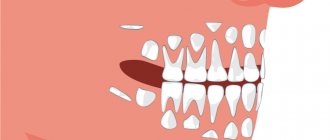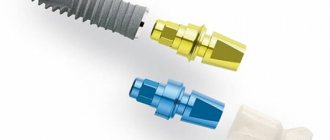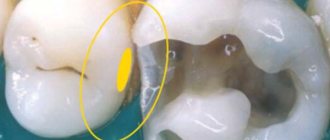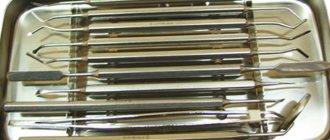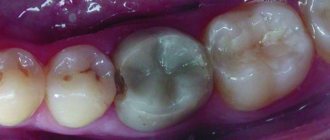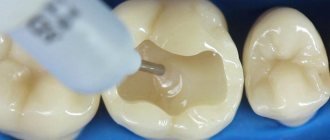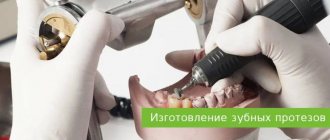What qualities should dental materials have?
- Do not cause allergic reactions;
- Do not contain harmful toxic substances;
- Do not create conditions in the oral cavity for the deposition of tartar;
- Maintain a smooth surface so that no particles of food remain in cracks or pits during food consumption;
- Prostheses must be resistant to mechanical loads so that they do not change their shape during use;
- Possess anti-corrosion properties;
- Be flexible during installation and rigid after completion of work.
When carrying out implantation and prosthetics, it is important to create an imitation of naturalness. That is, the mouth should close freely and the jaws should fit well together. It is important that the shade of new teeth does not stand out against the background of old ones. A person’s speech should remain coherent, and the timbre of his voice should remain the same.
Basic properties of dental materials
PART I
Practical lesson No. 1
| Subject: | Dental materials science is the applied science of materials for dentistry. “Ideal” dental material. Classification of dental materials and principles of its construction. Basic properties of materials and their significance for restorative dentistry. The concept of theoretical strength and stress concentration. |
| Target: | — study the objectives of the subject of dental materials science. — to form an idea of the concept of “ideal” dental material. — consider the classification of dental materials by chemical nature and purpose; - be able to characterize the physical, chemical and mechanical, technological, biochemical properties of materials and methods for their evaluation. |
| Method: | Group lesson. |
| Location: | Classroom, clinical room, dental laboratory, manual skills room, dental materials science laboratory. |
| Security: | Technical equipment: multimedia equipment, dental units, dental instruments, dental materials. Teaching aids: phantoms of the head and jaws, stands, multimedia presentations, educational videos. Means of control: control questions, situational tasks, questions for test control, homework. |
Lesson plan
1. Checking homework completion.
2. Theoretical part . Introducing the phantom office workplace. Definition of applied science of dental materials science. Requirements for an “ideal” material for restorative dentistry. Classification of dental materials by chemical nature and purpose. Basic properties of materials, methods of studying them. The concept of theoretical strength and stress concentration.
3. Clinical part . Demonstration by the teacher: student’s workplace, materials of various classes (ceramics, metals, polymers); dental materials: for the prevention of dental diseases and hygiene; restorative materials in therapeutic dentistry; materials in orthopedic dentistry for partial and complete loss of teeth; materials for the treatment of malocclusions and dentition; materials for surgical treatment of defects and deformations of the maxillofacial area.
4. Safety instructions.
5. Independent work. Students mastering the workplace, rules of conduct and appearance equipment. Study of dental materials by chemical nature and purpose.
6. Analysis of the results of students’ independent work and monitoring of acquired knowledge on test questions and situational tasks.
7. Test control of knowledge.
8. Assignment for the next lesson.
Safety precautions.
During practical classes, students must follow the following rules: observe the dress code - wearing special medical clothing (gowns, caps, replaceable shoes, long hair - under a cap), maintain sanitary and hygienic order in their workplace.
Before starting work, students must study the safety rules, which are drawn up in accordance with the “Rules for the design and operation of dental clinics, departments, offices and dental laboratories.” Before starting work, you must make sure that the devices are grounded and turned on; all maintenance and repair of equipment must be performed after they have been de-energized. After finishing work, dental equipment must be disconnected from the power supply. Caution must be exercised when working with potent substances. The preparation of dental materials must be carried out according to the instructions.
annotation
Dental materials science is a science that studies the interconnection of the composition, structure, properties, technology of production and use of materials for dentistry, as well as patterns of changes in the properties of materials under the influence of physical, mechanical and chemical factors. We are talking about factors operating in the specific conditions of the oral cavity during the functioning of the dentofacial system, which made it possible to identify dental materials as a separate field of knowledge.
Currently, practicing dentists understand that without in-depth knowledge of the properties of dental materials it is impossible to achieve the functional usefulness, aesthetics and durability of dental restoration. When planning a dental care plan, the doctor is always faced with choosing the most suitable material. Making the right choice, using only your experience and intuition, is not very easy, since the end of the twentieth century and the beginning of the current one were marked by the rapid development of dental materials, so the dentist must be able to assess the possibilities of new developments and new methods of using materials in the clinic, which requires a deep understanding relationships between their chemical bases and properties. Knowledge of the basics of materials science, differences in the properties of materials depending on their chemical nature, and application technology will allow the use of scientifically based criteria for selecting the right material in dental practice.
Despite significant achievements in dental materials science in recent years, none of the created materials can be considered “ ideal
"
“ ideal
” material for restorative dentistry must fully meet the following requirements:
— be biocompatible;
- resist all possible influences of the oral environment;
— ensure a strong and permanent connection with the structure of the hard tissues of the tooth;
— completely reproduce their appearance;
— have a complex of physical and mechanical properties corresponding to the properties of restored natural tissues and promote their regeneration.
All dental materials are divided into three main classes depending on their chemical nature:
— inorganic materials or ceramics;
- metals;
- polymers.
Each class, in turn, is divided into types that differ in structure and properties (Scheme 1).
Scheme 1. Classification of dental materials by chemical nature*.
*Based on WJO'Brien classification “Dental Materials and Their Selection”, Quintessence Publ.Co., Inc, 3rd ed., p.1.
Each class of materials, despite the family resemblance of the numerous types included in it, is characterized by a fairly wide range of properties. For example, metals and alloys included in the second class have different indicators of strength, melting point, color, but all metals are characterized by malleability, electrical and thermal conductivity, and a typical metallic luster. Metals have high strength and rigidity (high modulus of elasticity). Therefore, in restorative dentistry they are used when the prosthesis needs to withstand significant mechanical loads; at the same time, metals quickly conduct heat and are not aesthetically pleasing, which limits their use.
Ceramics and polymers are thermal insulators, have a light color and translucency, therefore, they can be used to protect teeth from changes in oral temperatures and to create aesthetic fillings and dentures that reproduce the natural appearance of natural teeth.
In dentistry, a combination of materials of different chemical natures is often used, since none of the materials can be considered ideal. The diversity of dental materials lies not only in their differences in chemical nature, but also in the features of their use in dentistry or in their purpose. Materials that have the same chemical nature, but different purposes, can differ significantly in composition and properties.
To systematize dental materials to make it easier to navigate when choosing a restorative material and selecting auxiliary and temporary materials used at the stages of treatment and manufacturing of dentures, a classification of materials based on the principle of their purpose in dentistry can be of great help.
This classification principle cannot be considered ideal, since some materials (for example, cements) have numerous applications in various fields of dentistry. But, despite this drawback, the proposed classification makes it possible to divide dental materials based on the basic requirements that are imposed on them by the conditions of use in a particular field of dentistry.
Classification of dental materials by purpose is the main classification of dental materials (Scheme 2).
Scheme 2. Basic classification of dental materials by purpose.
Basic properties of dental materials
The main goal of dental materials science is to create a set of “ideal” materials for the oral cavity. Operating factors in the oral cavity include: temperature fluctuations, high constant humidity, and the presence of an electrolyte environment. The listed factors are reflected in the properties of materials - physical, chemical, technical, technological, biological, aesthetic.
Modern dental production is an industrial complex that uses many technological processes: pressing, casting parts of a certain design, soldering, applying ceramic and plastic coatings, etc.; various devices are also used: for stamping, casting, vacuum furnaces for firing ceramics and etc.
All this requires from the orthopedic doctor not only knowledge of the technological process, but also the impact of its disruption on the properties of the material and the organs of the oral cavity and the body as a whole.
The physical properties of materials include: density, melting and boiling points, heat capacity, thermal conductivity, thermal coefficients of linear and volumetric expansion, surface tension, color, phase transformations, etc.
Dental materials science uses a variety of research and testing methods that make it possible to establish the nature of the material, composition, properties and, if necessary, determine the quality of finished dental products.
Methods of physical analysis : X-ray, X-ray diffraction, magnetic and ultrasonic flaw detection and dilatometric.
X-ray analysis
makes it possible to establish the types, types and sizes of crystal lattices of metals and alloys.
X-ray diffraction analysis
makes it possible to detect even microscopic defects inside the material.
Magnetic flaw detection
allows you to identify defects in the surface layer (up to 2 mm) of metal materials.
Ultrasonic flaw detection
allows for effective quality control at great depths.
Dilatometric method
is based on determining volume changes that occur in a material during phase transformations, and is used to determine crystalline points in solid samples.
Coefficient of thermal conductivity
measured by the amount of heat in calories per second that passes through a sample of material 1 cm thick and 1 cm3 in area when the temperature difference at the ends of the sample is 10C. The higher this indicator, the more capable the substance is of passing thermal energy through itself, and vice versa. The thermal conductivity coefficient is expressed in cal/cm·s·0С. (Table 1).
Table 1
What is needed for quality work?
Recently, the requirements for the quality of treatment are constantly increasing, and the level of services is rising. In order to offer the patient effective and painless treatment, it is necessary to correctly select the necessary materials. Therefore, the manufacturer chosen by the doctor plays a special role here.
It is important to understand that cheap products are not always of high quality, and not every client can afford expensive ones. Therefore, the doctor needs to find a middle ground where the price is optimal and the quality is decent.
Basic materials for dentist work:
- Dental materials that are necessary for filling canals and teeth;
- Tools for restoring the standard tooth shape;
- Disinfectants for working with tools and reusable surfaces. Allows the removal of microorganisms, ensuring strict compliance with sanitary requirements;
- Anesthetics are necessary for pain relief during planned procedures. Most procedures are painful, so anesthetics should be purchased in large quantities;
- High quality suture material. It must be safe for health and not cause allergic reactions in the body;
- Tools and equipment: scalpel, burs, tartar and plaque removers, tweezers, mirrors.
The above dental materials are necessary for surgical, endodontic, and implantation procedures. They are also necessary for the treatment of teeth and gums. The use of these tools ensures a high-quality work result, which is important for the doctor and the patient.
Dental community
21.06.2020, Site section: Current articles. Dentistry. Health care organization. Right.
“Pediatric Dentistry and Prevention”, No. 2 - 2020
Skripkina G.I., Doctor of Medical Sciences, Associate Professor, Head of Department Garifullina A.Zh., Candidate of Medical Sciences, Associate Professor Breslavskaya E.A., Clinical Resident
Department of Pediatric Dentistry, Omsk State Medical University
Summary
Relevance: Light-curing composite materials have a large number of indications for use and are actively used by dentists in clinical practice. The properties of these materials vary depending on their composition and filler size. We conducted a survey of dentists and therapists in public and private dental clinics in Omsk to determine the compliance, objective indicators of the physical and chemical parameters of the composite materials under study and their subjective assessment by doctors using these materials in their work.
Purpose: comparison of objective indicators of various properties of photocomposite materials with the subjective assessment of dentists.
Material and methods: study of the physicochemical properties of light-curing composite materials most often used in the practice of Omsk dentists in public and private clinics. A research design was developed and a survey of 148 dentists in Omsk was conducted to determine the subjective assessment of these materials.
Results: a comparative analysis of objective and subjective indicators of composite materials was carried out.
Conclusions: the data on the physical and chemical parameters of photocomposite materials fully correspond to the subjective assessment of dentists in Omsk.
Key words: Dental materials, composite materials, fluid-flowing composites, properties of materials, survey, questionnaire, dentists.
Introduction
Modern practical dentistry predominantly uses dental photocomposite filling materials for the treatment of carious and non-carious dental lesions due to their positive aesthetic and mechanical characteristics [1, 2, 3, 4]. Composite materials allow the doctor to carry out gentle preparation of teeth, restoration of teeth with defects of various shapes and configurations and have a number of physical and chemical advantages: high aesthetic properties, high strength, a wide range of colors [5, 6, 7], the ability to model and give an anatomical shape to the damaged crown part of the tooth, a stronger connection with the hard tissues of the tooth, better marginal adherence to the hard tissues of the tooth, biological tolerance to the tissues of the oral cavity [8, 9, 10, 11, 12, 13]. But such materials are also imperfect and are constantly being improved [14, 15, 16, 17].
The purpose of the work is to compare data on the objective physical and chemical properties of a number of composite materials with a subjective assessment of the same materials, in order to formulate practical recommendations for dental therapists.
Objectives: 1. Assessment of physical and chemical parameters of a number of composite materials. 2. Determination of subjective assessments of photocomposites by dentists in Omsk. 3. Analysis of objective and subjective parameters to formulate practical recommendations for dentists and therapists.
Material and research methods
Today, the market offers a huge selection of photocomposite materials from various manufacturers, both foreign and domestic. For the study, materials were selected that are most often used in the practice of Omsk dentists in public and private clinics based on the data obtained from a questionnaire survey in order to give a personal subjective assessment of these products.
The following methods were used in the work: sociological, analytical. We developed a research design and developed a questionnaire to compare the subjective assessment of composite materials with their physicochemical parameters.
Studies of the objective physical and chemical properties of the materials under study were carried out in June 2022 by a certified tester under the supervision of the head of the Research Center B.V. Ryabokon. The tests were carried out in accordance with national standards: GOST R 56924 - 2016 (ISO 4049 - 2009) “Dentistry. Polymer restorative materials" and GOST 31574-2012 "Dental polymer restorative materials". An objective assessment of the properties of materials is represented by the following parameters: depth of curing, diametric tensile strength, bending strength, consistency.
Our work involved the evaluation of the following composite materials (names/characteristics correspond to official registration documents):
- Filtek Ultimate Universal (3M ESPE) is a universal restoration material.
- Estelux NK (Stomadent) is a nanohybrid composite material.
- DentLight (VladMiVa) – microhybrid composite.
- Filtek Ultimate Flowable (3M ESPE) is a fluid-flowing restoration material.
- FlowRest (Stomadent) – low-modulus (flowable) composite
- DentLight Flow (VladMiVa) is a flowable composite.
Materials differ not only in price category, but also in their properties, which are reflected in the work process and its results. For the first three positions (packable composites) in the official registration documents, only the Estelux NK material from the Stomadent company contains the word “nanohybrid”; but in two other cases, both manufacturers position these products as “nanocomposites” and as materials made with the use of nanoadditives, as indicated on the manufacturers’ websites, as well as in their catalogs and presentation materials.
Research results and discussion
A questionnaire survey was conducted among 148 dental therapists in Omsk. In government institutions, the number of respondents was 92. Of these, 44.44% had work experience of more than 10 years, 22.22% had 5-10 years of experience, and 33.33% had less than 5 years of experience.
The number of surveyed doctors from private clinics is 56. The smallest number of them - 9.52% - are specialists with more than 10 years of work experience, 38.09% have less than 5 years of experience and the majority - 52.38% - have been working for 5-10 years.
When carrying out restoration, 59.25% of dental therapists in public clinics use a combination of condensed and liquid (flowing) composites, the remaining 40.74% use only condensed composites. In private institutions the situation is very different. The combination of “condensable and liquid (flowable) composites” is used in restoration by 95.23% of doctors.
The largest number of surveyed doctors from public and private clinics - 85% - use fluid-flowing composites when sealing fissures. 78% use these materials when filling using the layer restoration method. 77% - to restore minor enamel chips. 59% of doctors prefer liquid materials when filling Black class 2 cavities using the tunnel preparation technique. There was a slight majority of votes in favor of private practice. When restoring the marginal seal of fillings, flowable composites are used by 50% of doctors. Small cavities on the chewing surface are filled with liquid materials by 59% of surveyed doctors. Wedge-shaped defects and damage in the cervical part – 43%. Black class cavities 3 and 4 – 30%. 36% of respondents fix fiber systems and 21% fix splints using flowable composites. Most of them are doctors at private clinics.
Doctors use condensed composites in the following clinical situations. 95% use these materials to fill cavities of class 1 and 2 according to Black. 78% - when filling using the layer restoration method. 91% of doctors model the tooth stump with condensed composites. The smallest number of doctors in both groups – 13% – use these materials in the manufacture of indirect restorations. In the last two cases, there is a slight advantage in favor of private clinics.
An objective assessment of the properties of materials is reflected in Table No. 1 and is represented by the following parameters: depth of curing, diametric tensile strength, bending strength, consistency. In the note column, a description of tactile properties and strength is highlighted.
Table 1. Objective assessment of the physicochemical properties of the materials under study
| Name of material, Color of material | Curing depth, h mm | Strength at diametrical rupture, MPa (not less than 34 MPa) | Bending strength, MPa (not less than 80 MPa) | Consistency, mm | Note | ||||
| According to the manufacturer's instructions | h, mm in 10 sec. | ||||||||
| Curing time sec. | h, mm not less | h, mm actually | |||||||
| 1. | Filtek Ultimate Universal Restorative, EA3 | 20 | 2 | 2, 57 | 2, 18 | 60, 9±4, 3 | 119, 7±19, 3 | 16.5x16.5 | + Dense, but very flexible, easy to model, high strength. — Chips on the cured sample. |
| 2. | DentLight, DA3 | 30 | 2 | 2, 03 | 1, 60 | 48, 5±6, 5 | 108, 5±21, 0 | 19, 0х20, 0 18, 5х19, 0 | — Less ductile, long curing time, wide range of values (flexural strength) |
| 3. | Estelux NK, EA3 | 20 | 2 | 2, 76 | 2, 28 | 54, 0±3, 1 | 108, 4±8, 8 | 19.5x19.5 | + Plastic, easy to model |
| 4. | Filtek Ultimate Flowable Restorative, A3 | 20 | 2 | 2, 16 | 1, 85 | 52, 5±5, 0 | 117, 1±7, 3 | 30, 0x30, 0 | + Thixotropic, non-spreading, high strength |
| 5. | DentLight-Flow, A3 | 30 | 1, 5 | 2, 87 | 2, 15 | 38, 2±8, 0 | 83, 8±2, 9 | 40.0x40.5 | — Highly flowable, not thixotropic, long curing time, near minimum strength |
| 6. | FlowRest, A3 | 20 | 2, 0 | 2, 27 | 1, 86 | 42, 4±3, 2 | 95, 7±4, 5 | 26.5x26.5 | + Thixotropic, does not bleed |
Tests were carried out in accordance with the requirements of national standards:
- GOST R 56924-2016 (ISO 4049-2009) “Dentistry. Restorative polymer materials";
- GOST 31574-2012 “Dental Polymer restorative materials. Technical requirements. Test methods clauses 6, 12.
The material Filtek Ultimate Universal (3M ESPE) and DentLight Flow (VladMiVa) were used equally by doctors of private and public institutions, Estelux NK (Stomadent), DentLight (VladMiVa) and FlowRest (Stomadent) were used by the majority of doctors in public clinics, Filtek Ultimate Flowable (3M ESPE) – most doctors in private clinics.
According to objective indicators, among the packaging materials studied, Filtek Ultimate Universal and Estelux NK are practically at the same level. Filtek Ultimate Universal has better diametric tensile strength and flexural strength, but greater actual cure depth and 10 second cure depth. has Estelux NK. These indicators are directly reflected in the wear resistance and satisfaction with the quality of the restoration and its long-term results - both materials received the highest rating. In Table 1, in the notes column, among the advantages of the Filtek Ultimate Universal material, its density is indicated and fully corresponds to the doctors’ assessment of “excellent” for this property. The Estelux NK material received the same rating. Excellent ductility and modeling of these materials are listed as pluses among objective indicators and correlate with the doctors’ answers. Based on the “Adhesion to the instrument” parameter, doctors concluded that Filtek Ultimate Universal adheres to the instrument less than Estelux NK and DentLight. Filtek Ultimate Universal and Estelux NK are better polished than DentLite (see diagram 1). The Dentlight material, according to objective data, has a longer curing time, a smaller curing depth and diametric tensile strength than other tested representatives of packable composites. The disadvantages of this material include a wide range of bending strength values. For most of the properties assessed by doctors, this material was rated “good”, which is a consistently good result.
Diagram 1. Results of subjective assessment of the properties of packaged composite materials using a 10-point system
Among the studied fluid composites, according to the objective data in Table 1, the last position is occupied by the DentLight Flow material. FlowRest is objectively inferior to Filtek Ultimate Flowable material in terms of bending strength and diametrical tensile strength. The latter has an average consistency index among the fluid materials under study. According to survey responses from dentists, FlowRest received the largest number of “excellent” and “good” ratings. This material is thixotropic and does not spread (see Table 1); therefore, it is convenient for insertion and removal from the cavity. It should be noted that only 8% of the total number of doctors used this material. Filtek Ultimate Flowable is also thixotropic and does not spread, which doctors noted, rating the parameters “Plasticity” and “Ease of insertion and removal from the cavity” as “good”. In general, the doctors surveyed who used this material were satisfied with the quality of the restorations. DentLight Flow received the majority of “satisfactory” ratings from doctors; not a single property was identified that was completely dissatisfying to the respondents. All flowable materials were rated “satisfactory” according to the modeling parameter, which is logically explained by their physicochemical properties (consistency, fluidity) and indications for use (see diagram 2).
Diagram 2. Results of subjective assessment of the properties of fluid composite materials using a 10-point system
conclusions
Based on the data of a subjective assessment of the studied materials, obtained during a questionnaire survey of dentists and general practitioners in the city of Omsk, and taking into account the objective assessment of their physical and chemical parameters, we made the following conclusions. These physical and chemical parameters are fully consistent with the subjective assessment of dentists. Among the group of packable composite materials, according to objective criteria, the leading position is occupied by Filtek Ultimate Universal (3M ESPE), this is confirmed by the answers of dentists. Estelux NK (Stomadent) takes second place in terms of objective parameters, but, according to the subjective assessment of doctors, it is practically not inferior to the leader.
When evaluating liquid-flowing materials, doctors gave preference to FlowRest (Stomadent). It is necessary to take into account the fact that this is only 8% of respondents. Filtek Ultimate Flowable (3M ESPE) is ahead of FlowRest by objective assessment, but takes second place by subjective assessment. Doctors are equally satisfied with the quality of restorations using both materials.
We recommend packable materials for clinical use - Estelux NK, Filtek Ultimate Universal and flowable materials - FlowRest and Filtek Ultimate Flowable for private and public dental institutions, taking into account the peculiarities of the pricing policy.
Bibliography
- Aleynikov K.V., Vagner V.D. Efficiency of dosing light-cured composite materials using standard and modified methods // Dentistry for everyone. 2010, 4, 16-18.
- Vikulin A.V., Markin A.V. Results of using low-modulus light-cured composite material “Flourest” to restore the gingival margin // Dental Forum. 2012, 5, 35.
- Vasilenko A.V., Vikulin A.V., Ibragimov T.I., Stetsyura O.A. Application of light-curing hybrid composite material for aesthetic restoration of the gingival margin // Dental Forum. 2016; 4, 18.
- Getsman A.V. Restoration of temporary incisors of the upper jaw // Pediatric dentistry and prevention. 2015; 14; 4 (55), 17-18.
- Blokhina A. A. Options for solving the current problem of restoring cavities in lateral teeth // DentArt. – 2012; 1, 52-57.
- Danilova M.A., Machulina N.A., Shevtsova Yu.V., Kamenskikh D.V. Clinical and experimental rationale for the use of various filling materials in preschool children // Pediatric dentistry and prevention. 2019; 19; 2(70), 31-36.
- Maslak E. E. Prevalence of dental caries and modern directions of caries prevention // Medical alphabet. 2015; 1; 1, 28-31.
- Nikolaenko S.A., Pechenegina E.V., Zubarev A.P., Fedorov Yu.V., Lobauer U. Comparative characteristics of the wear resistance of modern polymer composites // Clinical dentistry. 2022, 3 (83), 4-9.
- Mochalov Yu. A. Methodological approaches to the clinical assessment of dental photocomposite filling materials as medical products // Universum. Medicine and dentistry. 2022, 9(64).
- Caixeta RV, Guiraldo RD, Kaneshima EN, Barbosa AS, Picolotto CP, Lima AE, Gonini Junior A, Berger SB. Push-Out Bond Strength of Restorations with Bulk-Fill, Flow, and Conventional Resin Composites. 2015;2015:452976. doi:10:1155/2015/452976.
- Furuse A., Gordon K., Rodrigues F. et al. Watts Color-stability and gloss-retention of silorane and dimethacrylate composites with accelerated aging. — J. Dentistry, 2008, v. 36, No. 11, r. 945-952
- Monterubbianesi R, Orsini G, Tosi G, Conti C, Librando V, Procaccini M, Putignano A. Spectroscopic and Mechanical Properties of a New Generation of Bulk Fill Composites. Front Physiol. 2016 Dec 27; 7, 652. doi: 10:3389/fphys.2016, 00652.
- Radhika M, Sajjan GS, Kumaraswamy BN, Mittal N. Effect of different placement techniques on marginal microleakage of deep class-II cavities restored with two composite resin formulations. J Conserv Dent. 2010; 13, 9-15.
- Skripkina G.I., Garifullina A.Zh. Clinical examination as the main clinical approach to the prevention of dental caries in children // Dentistry. 2015;94;5:64-66.
- Skripkina G.I., Garifullina A.Zh., Mityaeva T.S., Romanova Yu.G., Mikhailovsky S.G., Dmitrieva V.A. Experience in the use of dual-curing composite material for fixation of fiberglass pins and restoration of the tooth stump in the practice of a pediatric dentist // Endodontics Today. 2015; 3, 35-37.
- Korolenkova M.V., Arzumanyan A.P. Comparative analysis of microleakage of fillings and standard pediatric crowns during the restoration of temporary molars after simulated pulpotomy // Pediatric Dentistry and Prevention. 2019;19;1(69):46-50.
- Effect of surface sealants on marginal microleakage in Class V resin composite restorations / SV Silva Santana // J. Esthet. Dent. - 2009. - Vol. 21, No. 6. - P. 397-404.
Conflict of interest: The authors declare no conflict of interest
Received: February 11, 2022
Skripkina Galina Ivanovna – Doctor of Medical Sciences, Associate Professor, Head of the Department of Pediatric Dentistry of the Federal State Budgetary Educational Institution of Higher Education "Omsk State Medical University" of the Ministry of Health of the Russian Federation For correspondence
Garifullina Albina Zhamilievna – Candidate of Medical Sciences, Associate Professor, Associate Professor of the Department of Pediatric Dentistry of the Federal State Budgetary Educational Institution of Higher Education "Omsk State Medical University" of the Ministry of Health of the Russian Federation For correspondence
Breslavskaya Evgeniya Aleksandrovna – clinical resident of the second year of study of the Department of Pediatric Dentistry of the Federal State Budgetary Educational Institution of Higher Education "Omsk State Medical University" of the Ministry of Health of the Russian Federation For correspondence
Views 1107 Likes 1 Like
